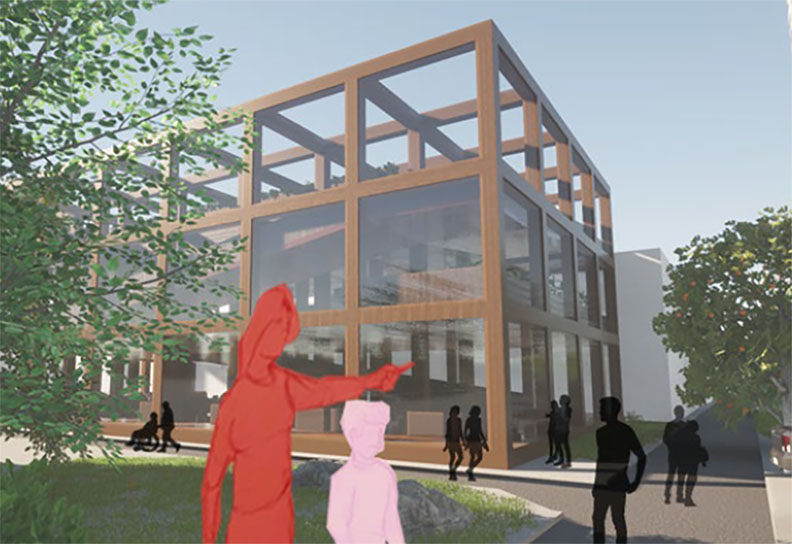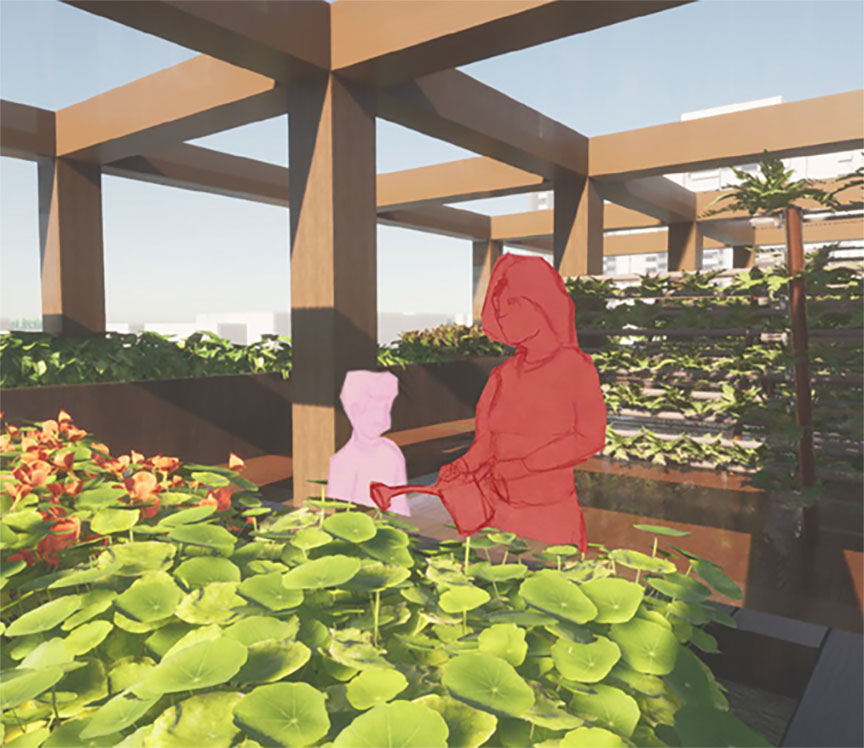ALICIA KEMPENAAR • PARLEEN KANG • SAIF AKBAR • BRIANA DECINA • CAESAR ADWAN• JACKON WARWICK
Polaris
Fostering Health and Prosperity
![]()
![]()
![]()
![]()
![]()
POLARIS
Also known as the northern star. Polaris is a star that is a part of the Milky Way. Throughout history this star has been used as a tool to help guide people home. Like the star, the gardening centre tethers people to a community and sense of bringing you home.
Polaris
Fostering Health and Prosperity





POLARIS
Also known as the northern star. Polaris is a star that is a part of the Milky Way. Throughout history this star has been used as a tool to help guide people home. Like the star, the gardening centre tethers people to a community and sense of bringing you home.
HEALTH & ACCESSIBILITY:
Leslie says “I am not diagnosed with depression anymore and that’s directly related to having a healthy diet, [having shelter],... and feeling good about the function I’m performing in life today being involved in projects like this.”
Overall, there is a strong need from the community to increase the capacity for urban agriculture in the neighbourhood in order to improve food security and supplement income with food harvests. While HOPE garden only has 50 free plots, they are at full capacity with long waiting lists for those interested in joining.
INCOME AND SOURCE STABILITY:
Rather than relying on charity, the community aims to create their own food production network... they envision the neighbourhood moving forward in terms of food security and
health. Their four main directions are enhancing food literacy and skills development, creating a community food hub, building a community-based food processing social enterprise, and
increasing food production and decent work.
The Milky Way Garden began in 2007 asa response from recent immigrants andrefugees learning ESL in the basementof the Parkdale Library. Tish Carnat, an instructor of the class and founder of thegarden explains, “I asked the students‘Do you like vegetables?’ ... and there was dead silence ... when I said ‘What’swrong? Don’t you like vegetables?’ theysaid ‘Of course we do but they’re rathercostly.’ and I realized we needed to grow
our own vegetables.”
Leslie says “I am not diagnosed with depression anymore and that’s directly related to having a healthy diet, [having shelter],... and feeling good about the function I’m performing in life today being involved in projects like this.”
Overall, there is a strong need from the community to increase the capacity for urban agriculture in the neighbourhood in order to improve food security and supplement income with food harvests. While HOPE garden only has 50 free plots, they are at full capacity with long waiting lists for those interested in joining.
INCOME AND SOURCE STABILITY:
Rather than relying on charity, the community aims to create their own food production network... they envision the neighbourhood moving forward in terms of food security and
health. Their four main directions are enhancing food literacy and skills development, creating a community food hub, building a community-based food processing social enterprise, and
increasing food production and decent work.
The Milky Way Garden began in 2007 asa response from recent immigrants andrefugees learning ESL in the basementof the Parkdale Library. Tish Carnat, an instructor of the class and founder of thegarden explains, “I asked the students‘Do you like vegetables?’ ... and there was dead silence ... when I said ‘What’swrong? Don’t you like vegetables?’ theysaid ‘Of course we do but they’re rathercostly.’ and I realized we needed to grow
our own vegetables.”
COMMUNITY OPPORTUNITIES:
...at HOPE garden the senior immigrants who shared the space with a group of at-risk youth had different views on respectful behaviours due to Eastern and Western cultural differences...
However, after some time sharing the same space, working together on art projects, and participating in cooking workshops, the two groups gained a better understanding of each other.
Since the Milky Way garden is not city-owned, the community can sell what they grow. This creates an opportunity for a self-sustaining local food economy to flourish...
HOW MIGHT WE...
...at HOPE garden the senior immigrants who shared the space with a group of at-risk youth had different views on respectful behaviours due to Eastern and Western cultural differences...
However, after some time sharing the same space, working together on art projects, and participating in cooking workshops, the two groups gained a better understanding of each other.
Since the Milky Way garden is not city-owned, the community can sell what they grow. This creates an opportunity for a self-sustaining local food economy to flourish...
HOW MIGHT WE...
- Address the concern of a lack of space, to create larger gardening/community spaces and find ways to optimize the available space?
- Maximize food production capacity on community owned land to sustain Parkdale’s low-income population?
- Work and connect with pre-existing programs in the community to expand on available resource?


Themes Identified:
- The added cost of importing food has resulted in healthy foods being too expensive for many residents
- The community needs to increase their capacity for urban agriculture in order to improve food security and supplement income
- The community needs to increase their capacity for urban agriculture in order to improve food security and supplemental inome.
- Growing food in a cost-effective way that is also affordable for community members
- The community acting collectively and being able to take ownership of their work
- The community turning efforts into future opportunities and sources of income
- Learning opportunities within their own community.
- Community members are looking for their garden spaces to have a numberof uses.
- Connecting senior immigrants with at risk youth forms stronger communitybonds.
Insights:
- We noticed that low income families within the Parkdale communities don’thave access to healthy food options within the communities , this is becausehealthy foods come with a premium cost that covers shipping costs.
- We noticed that a large percentage of community members are low income /no income, thus they opt for cheaper alternatives to healthy foods but thereare programs such as The Parkdale Food Network (PFN) available for the community to provide healthy food options to those in need.
- We noticed that turning community efforts and production may return economic benefits to the community and bring business opportunities.
- We noticed that immigrants and refugees in the community could not affordfresh produce but the implementation of locally grown food provides affordable pricing and food security for the community of Parkdale.
- We noticed that there is a large diverse number of immigrants within thecommunity. thus needs to be unifying force that bring the Parkdale community together.
- We noticed that different cultures have different healthy foods. As different cultures come together they can inturn diversify the community.
Summary of the Program and Development
This development is meant to modify and enhance the existing space. The site of our design is located on the Milky WayCommunity Garden. Since the Milky Way Garden is a community-owned space, community members have the freedom to grow their own fresh produce and create opportunities to not only make healthier meals, but have a supplemental income.
The development is a multi-storey indoor agricultural facility that has space for a market at street level for the community members to sell their produce on weekends. Not only does it provide them the ability to grow their own healthy food rather than outsource for prices that many low-income households cannot afford, it establishes a gathering space and sense of community to work by their own terms, with a community council who can be appointed to run the facility.
The design is a modular structure, that is able to be scaled, replicated and modified in order to suit different sites and needs that benefit the Parkdale community. Panels are able to be installed within the framing of the structure in order to address the needs of different spaces. Opaque, transparent, shelving units, and open-air are some of the options for the panel system. The flexibility of the facade panels, allowing for means produce can be grown year-round.
Several strategies are implemented to maximize these benefits and reduce cost and keep strain on resources to a minimum. One strategy is to introduce aquaponic and hydroponic systems to make the best use of space with healthy, nutrient-rich plants. Modular raised garden bed layouts and mechanisms allow for a diverse range of plants to be grown that couldn’t be grown using the aquaponic system.
This development is meant to modify and enhance the existing space. The site of our design is located on the Milky WayCommunity Garden. Since the Milky Way Garden is a community-owned space, community members have the freedom to grow their own fresh produce and create opportunities to not only make healthier meals, but have a supplemental income.
The development is a multi-storey indoor agricultural facility that has space for a market at street level for the community members to sell their produce on weekends. Not only does it provide them the ability to grow their own healthy food rather than outsource for prices that many low-income households cannot afford, it establishes a gathering space and sense of community to work by their own terms, with a community council who can be appointed to run the facility.
The design is a modular structure, that is able to be scaled, replicated and modified in order to suit different sites and needs that benefit the Parkdale community. Panels are able to be installed within the framing of the structure in order to address the needs of different spaces. Opaque, transparent, shelving units, and open-air are some of the options for the panel system. The flexibility of the facade panels, allowing for means produce can be grown year-round.
Several strategies are implemented to maximize these benefits and reduce cost and keep strain on resources to a minimum. One strategy is to introduce aquaponic and hydroponic systems to make the best use of space with healthy, nutrient-rich plants. Modular raised garden bed layouts and mechanisms allow for a diverse range of plants to be grown that couldn’t be grown using the aquaponic system.

Programming:
Our team decided to incorporate three levels into the facility. On the street level we decided to have a market place where community members can register for the use of a stall to sell the produce that the grow to obtain supplemental income. On the upper floors is where the aquaponic systems and gardens are located. This process of gardening also allows for social engagement amongst participants and creating a sense of community.



Systems:
We determined that within our facility we would include systems that would help to maximize the benefits of the space. By incorporating vertical gardening systems such as aquaponic and hydroponic systems into the growing process, this will allow for higher yields. These systems will help to address the desire to grow more healthy and fresh food among low-income families. Gardening systems such as vertical gardening, rotation and pulley systems will be implemented to maximize both vertical and horizontal space.



Modular Design:
Our team experimented with simple structural design elements that could be built upon to allow for flexibility and customizability. Since this design has the option to be enclosed, the facility will be able to be used year round making fresh produce more accessible.